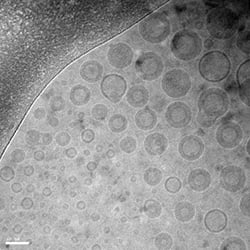Mucosal membranes play an important role in the human body. Present in such places as the lungs and the gastrointestinal and reproductive tracts, the protective layer acts as a first defense against incoming infections. And infusing this membrane with vaccines can help bolster the body's defenses against infectious diseases and cancer. The problem, though, is with the delivery; getting vaccines to stay in the membrane long enough to trigger an immune response can be tricky, especially in the lungs.
 |
| Nanoparticles designed to deliver vaccines to mucosal surfaces--Courtesy of MIT |
To overcome this obstacle, MIT engineers reported in Science Translational Medicine that they have developed nanoparticles to carry vaccines to the mucosal surface in the lungs, protecting them long enough to provoke an immune response. Furthermore, vaccines delivered this way can stave off infection at other mucosal surfaces throughout the body, so in addition to influenza and other respiratory viruses, the encapsulated vaccines could help prevent sexually transmitted diseases such as HIV, herpes simplex virus and human papillomavirus, the university reports. The team is also looking into the platform as a way to deliver cancer vaccines.
As with many delivery vehicles, the structure of the nanoparticle is what gives it stability--its multiple layers keep the virus safe until immune cells on the lung's surface bring them to T cells, which then form an immune "memory" associated with that type of infection, preventing further susceptibility. Without the nanoparticle vehicle, the viruses can be whisked away before they can do their job.
"The nanoparticles comprise lipid nanocapsules, where the walls of the capsule are 5-10 stacked lipid bilayers chemically linked one to another," MIT professor and lead author Darrell Irvine told FierceDrugDelivery. "This structure makes them stable in the extracellular environment of the lungs, allowing more time for antigen-presenting cells to collect the particles and deliver them to lymph nodes to initiate the immune response."
Irvine said the nanoparticle method, which showed in mouse models to successfully contain the virus within the lungs and form a strong memory T cell presence in other mucosal surfaces throughout the body, has been licensed to Vedantra, a startup company working to bring the platform to human testing.
The researchers took a big step in vaccinating against cancer using this method, as well: In mice implanted with melanoma tumors, the ones given the nanoparticle treatment rejected the cancer, while the others with uncoated vaccines did not, according to MIT.
The team's work with both cancer and infectious diseases has drawn funding from the National Cancer Institute, the Ragon Institute, the Bill & Melinda Gates Foundation, the U.S. Department of Defense and the NIH.
"Vaccinating through mucosal surfaces promotes strong immunity at those surfaces--so the pulmonary vaccination here gave greatly enhanced protection against a respiratory viral challenge," Irvine said. "This could be relevant for vaccines against influenza (and other pandemic flus), RSV, and perhaps reproductive tract pathogens like HIV, HSV and HPV."
- here's the MIT report
- and the research abstract